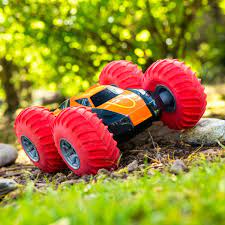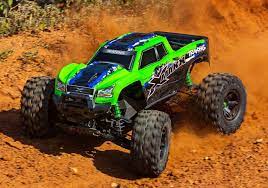RC cars guide
Here’s a guide to help you get started with RC cars:
Types of RC Cars:
- On-Road Cars: These RC cars are designed for high-speed racing on smooth surfaces like pavement or tracks. They have low ground clearance and sleek, aerodynamic bodies for optimal performance and handling on flat surfaces.
- Off-Road Cars: Off-road RC cars are built to handle rough terrains such as dirt, grass, and gravel. They typically have higher ground clearance, larger tires with deeper treads, and durable suspension systems to handle bumps, jumps, and uneven surfaces.
- Buggies: Buggies are versatile RC cars that can be driven both on-road and off-road. They are designed to offer a balance between speed, handling, and off-road capabilities. Buggies usually have a rear-wheel-drive configuration and longer suspension travel for better off-road performance.
- Trucks: RC trucks are often larger and more rugged compared to other types of RC cars. They are designed for off-road adventures and can handle rough terrains, including rocks, hills, and obstacles. RC trucks may feature four-wheel drive, lifted suspension, and aggressive tire patterns for enhanced off-road performance.
- Drift Cars: Drift RC cars are specifically designed for performing controlled slides and drift maneuvers. They have specialized tires with low traction to allow the rear end of the car to slide easily. Drift cars usually have rear-wheel drive and unique setups to facilitate controlled drifting on smooth surfaces.
- Crawlers: RC rock crawlers are designed to navigate challenging terrains with obstacles like rocks, hills, and uneven surfaces. They feature low gearing, high torque motors, and articulated suspension systems to provide excellent crawling capabilities. Crawlers often have four-wheel drive and adjustable suspension to tackle various obstacles.
- Monster Trucks: These RC cars are larger in size and built to resemble real-life monster trucks. They are designed for extreme off-road performance, including high jumps and aggressive stunts. Monster trucks often have large tires, long-travel suspension, and powerful motors to handle rough terrains and perform impressive tricks.
Electric vs. Nitro/Gas-Powered
When it comes to RC cars, you have the option to choose between electric and nitro/gas-powered models. Here’s a comparison between the two:
Electric RC Cars:
- Power Source: Electric RC cars are powered by rechargeable batteries, usually lithium-ion or nickel-metal hydride (NiMH) batteries. They are easy to charge and provide consistent power throughout your driving session.
- Operation: Electric RC cars are quieter and produce less noise compared to nitro/gas-powered cars. They are also generally easier to operate and maintain, making them suitable for beginners and those who prefer a hassle-free experience.
- Speed: Electric RC cars can achieve impressive speeds, especially high-end brushless models. However, the top speeds of electric cars are typically lower than nitro/gas-powered cars.
- Maintenance: Electric RC cars have fewer maintenance requirements. You’ll need to periodically check and replace batteries, as well as maintain the electronic components and motors. Overall, they are relatively low-maintenance compared to nitro/gas-powered cars.
- Environmentally Friendly: Electric RC cars are more environmentally friendly since they produce zero emissions and do not require the use of fuel or oil.
Nitro/Gas-Powered RC Cars:
- Power Source: Nitro/gas-powered RC cars use a small internal combustion engine that runs on a mixture of nitro fuel (usually methanol), oil, and sometimes nitromethane. These cars require fuel and ignition systems to operate.
- Performance: Nitro/gas-powered RC cars offer higher speeds and acceleration compared to electric cars. The sound and smell of the engine add to the realism and excitement of driving.
- Tuning and Adjustments: Nitro/gas-powered cars often require tuning and adjustments for optimal performance. This involves adjusting carburetors, tuning the engine, and maintaining proper fuel-to-air ratios. This aspect can be challenging for beginners but is enjoyable for enthusiasts who like to tinker with engines.
- Fuel and Maintenance: Nitro/gas-powered RC cars require fuel and regular maintenance of the engine, including cleaning air filters, replacing glow plugs, and tuning the engine. They have more intricate mechanical components, so they may require more attention and care compared to electric cars.
The choice between electric and nitro/gas-powered RC cars depends on personal preference, experience level, desired speed, and the overall experience you’re looking for. Electric RC cars are generally more user-friendly, quieter, and easier to maintain, while nitro/gas-powered cars offer a higher level of realism, speed, and tuning options. Consider your priorities and the type of driving experience you seek before making a decision.

Scale Size:
- Realism: If you prioritize realism and want your RC car to closely resemble the real-life vehicle it’s based on, choosing a scale size that accurately reflects the proportions is essential. This can enhance the visual appeal and authenticity of the RC car.
- Performance and Handling: Smaller scale RC cars tend to be lighter https://takizo.shop and more agile, making them suitable for tight spaces or indoor tracks. On the other hand, larger scale RC cars often have more stability and can handle rough terrains better due to larger wheels and improved suspension systems.
- Space Requirements: Consider the available space where you plan to drive or store the RC car. Larger scale RC cars require more room to operate and may not be suitable for small indoor areas or confined spaces. Smaller scale RC cars are more suitable for indoor use or areas with limited space.
- Cost: Generally, smaller scale RC cars are more affordable compared to larger scale models. They often require less material and have fewer intricate details, making them a cost-effective choice. Larger scale RC cars tend to be more expensive due to their increased size and complexity.
Common scale sizes for RC cars include 1:10, 1:8, 1:18, and 1:24, among others. However, it’s important to note that the availability of specific scale sizes may vary depending on the brand and model of the RC car you are interested in.
Ready-to-Run (RTR) vs. Build Kits:
When choosing an RC car, you’ll come across two main options: Ready-to-Run (RTR) cars and kits to assemble. Here’s a breakdown of both options:
- Ready-to-Run (RTR) RC Cars:
- RTR cars come pre-assembled and ready to use right out of the box. They are designed for beginners and those who prefer a convenient and straightforward experience.
- Advantages:
- Convenience: RTR cars are ideal for beginners or those who don’t have much experience with RC car assembly. They are ready to go as soon as you unbox them, requiring minimal setup.
- Time-Saving: With an RTR car, you can quickly get into the hobby without the need for extensive assembly or technical knowledge.
- Complete Package: RTR cars often come with a compatible transmitter/controller, battery, and charger, so you have everything you need to start driving.
- Considerations:
- Limited Customization: RTR cars may have limited options for customization or upgrades compared to kits. They are built with pre-selected components, which may restrict modifications.
- Price Range: RTR cars are available in various price ranges, depending on their features, performance, and quality. Higher-end RTR models may offer more advanced features but come with a higher price tag.
- Kits to Assemble:
- RC car kits require you to assemble the car from individual components. They offer a more hands-on and customizable experience.
- Advantages:
- Customization: Building an RC car from a kit allows for greater customization. You can choose specific components, upgrade parts, and personalize the design to suit your preferences.
- Learning Experience: Kits provide an opportunity to learn about the different components and mechanics of an RC car. It can be a rewarding experience for those interested in the technical aspects.
- Upgradability: Assembling a kit gives you the flexibility to upgrade and modify the car over time. You can gradually improve its performance, durability, and features as your skills and knowledge grow.
- Considerations:
- Time and Skill Requirement: Building a kit requires time, patience, and some technical skills. It’s important to have the necessary tools and follow the instructions carefully.
- Additional Components: Kits typically require separate purchase of components like the transmitter/controller, battery, and charger. Make sure to factor in the cost of these additional items.
- Assembly Challenges: Some kits may be more complex and challenging to assemble, especially for beginners. Start with a kit suitable for your skill level and gradually progress to more advanced models.
Controllers and Frequencies
When choosing RC cars, it’s important to consider the controllers and frequencies they operate on. Here’s an overview of controllers and frequencies in radio control:
- Controllers:
- Transmitter/Controller: The transmitter or controller is the handheld device you use to control your RC car. It sends signals to the car’s receiver, which then translates them into actions such as steering, throttle control, and other functions.
- Features: Different controllers may have various features such as multiple channels, trim adjustments, steering dual-rate, throttle endpoints, and more. Advanced controllers may offer programmability and customization options.
- Compatibility: Ensure that the controller you choose is compatible with your RC car model and its receiver. Some cars come with a specific transmitter, while others may allow you to use third-party controllers.
- Frequencies:
- 2.4GHz: This is the most common frequency used in modern RC systems. It provides reliable and interference-free control, allowing multiple RC cars to operate simultaneously without signal conflicts.
- 27MHz and 49MHz: These frequencies were commonly used in older RC systems. However, they are susceptible to interference from other electronic devices and have limited channel options.
- Frequency Crystals: In the past, RC systems used frequency crystals to determine the operating frequency. Each car required a specific crystal, and multiple cars on the same frequency could not operate together. This system is less common nowadays due to the prevalence of 2.4GHz systems.
When choosing RC cars, it’s essential to ensure that the controller and car operate on compatible frequencies. Most modern RC cars and controllers use the 2.4GHz frequency, which offers reliable control and eliminates the need for frequency matching.
If you plan to run multiple RC cars simultaneously, make sure that each car and controller pair operate on different channels within the 2.4GHz frequency band. This allows you to run multiple cars without signal interference or conflicts.
It’s also worth noting that some higher-end RC systems offer features like telemetry, which allows you to monitor various parameters of your RC car, such as battery voltage or motor temperature, through the controller.
Related Posts
Leave a Reply Cancel reply
You must be logged in to post a comment.


